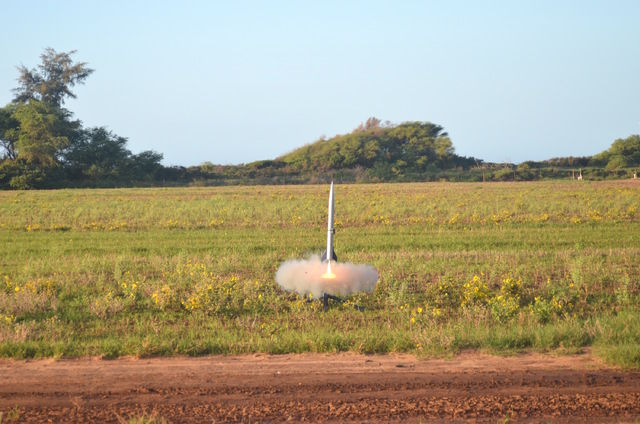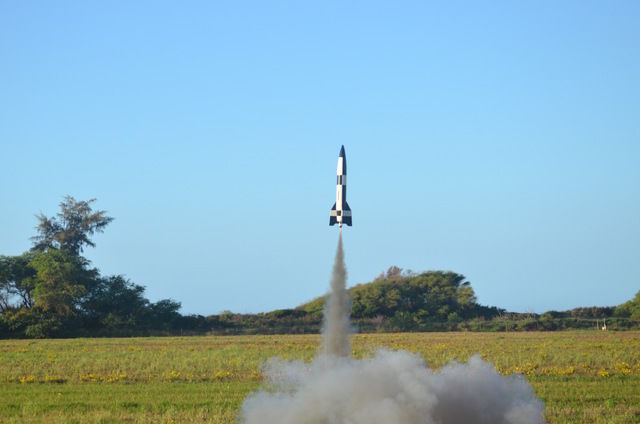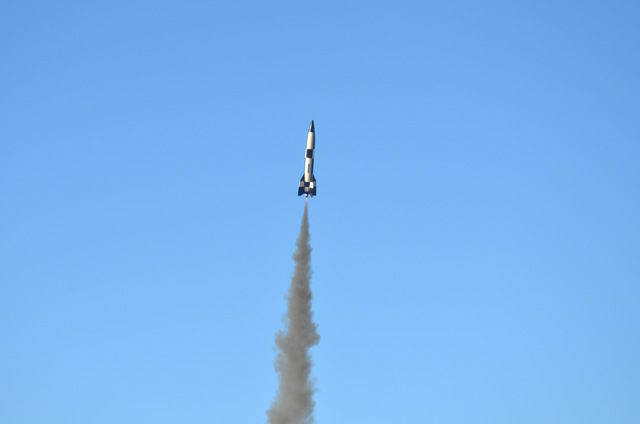KEKAHA — Waimea High School Principal Mahina Anguay issued a challenge a couple years back to math teacher Jerry Nishihira, to “aim higher” with his Directed Studies course that built homemade scratch rockets. Nishihira didn’t know what Anguay meant by
KEKAHA — Waimea High School Principal Mahina Anguay issued a challenge a couple years back to math teacher Jerry Nishihira, to “aim higher” with his Directed Studies course that built homemade scratch rockets.
Nishihira didn’t know what Anguay meant by that request.
“We didn’t know if that meant to built a bigger rocket or what, we didn’t know what she meant,” Nishihira said. “So I took that back to the class and asked do you think that’s what she means? Or to do something bigger and better.”
But Nishihira and his class didn’t just aim higher, they soared thousands of feet into the air.
Nishihira and his two students from his Video Rocketry class took their rockets to Syngenta Seeds Friday morning and launched self-made rockets into the air, some of which soared over 2,000 feet into the sky.
“In class, we built this initiator rocket and we’re out here launching it,” said junior D.J. Pabre. “It was a really long process. I think we started building this in October or November. It’s a relief. I was hoping that the parachute would eject so that it would land safely and it thankfully it did.”
These rockets aren’t the ones you can buy in the store and launch in a driveway, however. They’re much more advanced and technical. Furthermore, each rocket was hooked up with a HD Mobius Action Camera that recorded the launch from the rocket’s perspective.
“It’s a HD camera and it’s mounted externally. It’s called an onboard capture,” Nishihira told The Garden Island. “We set it up, launch it with the rocket and then take it off when it lands. Then they’ll (the students) edit and put together a video of the launch.”
Passionate about project-based learning, Nishihira sees this project as an opportunity to expand his teaching techniques outside of the classroom.
“The kids are having so much fun but they don’t know that they’re learning about algebra, trigonometry, physics, technology and engineering,” he said. “You can tell by the smiles on their faces that they like this class. It’s the new thing to do; it’s project-based learning. It doesn’t have to be rocketry, it could be robotics, electric cars, farming, any type of project-based learning that can grab a kids attention.”
Junior Corey Agena was the other student whose rocket was launched into the early morning sky. To him, this class is a stepping stool for his continued education into the world of engineering.
“I want to go into engineering so this type of stuff is good for me,” Agena said. “It was fun and I learned a lot. It felt good and like D.J. said, it was a relief because last time, my rocket didn’t come down very well.”
Next March, Nishihira plans to livestream the rocket’s launch using these HD cameras like he did in March. He said that during the livestream, 22 different countries watched the launch.
“Our claim to fame is that we’re the first high school in the state and I think that we’re the first high school in the nation that did that,” Nishihira said.
While both Pabre and Agena have another year and a half left of high school, both have expressed interest into pursuing a career in science and technology fields.
“They might go into engineering, they might go into science, they might go into medicine, they might go into business or whatever but anything that involved high levels of math, I think they’ll be ready for it,” he said.




